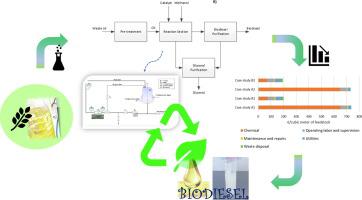Waste Management ( IF 8.1 ) Pub Date : 2021-01-18 , DOI: 10.1016/j.wasman.2020.12.034 Valentina Innocenzi , Marina Prisciandaro

|
Biodiesel production calls for innovative solutions to turn into a competitive process with a reduced environmental impact. One of the process bottlenecks stands in the immiscibility of oil and alcohol as raw materials, so mixing process largely impacts the overall process cost. This process step, if carried out by using hydrodynamic cavitation, has the possibility to become a benchmark for large scale applications. In this paper a process analysis of biodiesel production scheme is developed starting from two different feedstocks, virgin oil and waste cooking oil. At the first the traditional process scheme has been simulated, in a second simulation, the reactor for the biodiesel production is interchanged with a hydrodynamic cavitation reactor. In the paper, the comparison between the traditional and innovative process by using life cycle costing approach has been presented, thus providing indications for industrial technological implementation coming from a professional tool for process analysis. It is worth noting that the introduction of hydrodynamic cavitation reduces of about 40% the energy consumption with respect to the traditional process. As regards the total treatment costs, when using virgin oil as feedstock, they were in the range 820–830 €/t (innovative and traditional process, respectively); while starting from waste cooking oil the costs decreased of about 60%, down to 290–300 €/t (innovative and traditional process, respectively).
中文翻译:

从原始油和废食用油生产生物柴油的技术可行性:基于流体动力空化的传统工艺与创新工艺的比较
生物柴油生产需要创新的解决方案,以使其成为具有降低环境影响的竞争性过程。工艺瓶颈之一是油和醇作为原料的不溶混性,因此混合工艺在很大程度上影响了总体工艺成本。如果通过使用水力空化进行该工艺步骤,则有可能成为大规模应用的基准。本文从两种不同的原料,即初榨油和废食用油出发,对生物柴油生产方案进行了过程分析。首先,对传统工艺方案进行了模拟,在第二次模拟中,将用于生产生物柴油的反应器与流体动力空化反应器互换。在纸上 通过使用生命周期成本法对传统过程和创新过程进行了比较,从而为工业技术实施提供了来自过程分析专业工具的指示。值得注意的是,与传统工艺相比,引入水力空化可减少约40%的能耗。关于总处理成本,当使用原始油作为原料时,价格在820-830€/ t范围内(分别为创新工艺和传统工艺);从废食用油开始,成本降低了约60%,降至290-300欧元/吨(分别为创新工艺和传统工艺)。值得注意的是,与传统工艺相比,引入水力空化可减少约40%的能耗。关于总处理成本,当使用原始油作为原料时,价格在820-830€/ t范围内(分别为创新工艺和传统工艺);从废食用油开始,成本降低了约60%,降至290-300欧元/吨(分别为创新工艺和传统工艺)。值得注意的是,与传统工艺相比,引入水力空化可减少约40%的能耗。关于总处理成本,当使用原始油作为原料时,价格在820-830€/ t范围内(分别为创新工艺和传统工艺);从废食用油开始,成本降低了约60%,降至290-300欧元/吨(分别为创新工艺和传统工艺)。


























 京公网安备 11010802027423号
京公网安备 11010802027423号